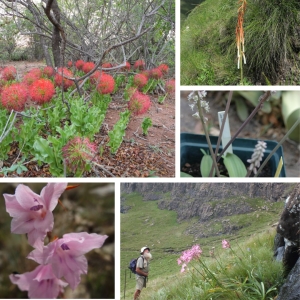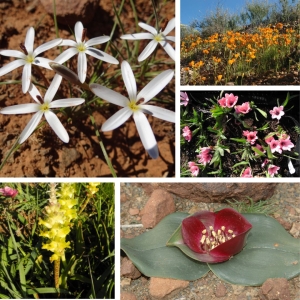Growing Hints 3: Bulbous Plants
Summer Growing Bulbs

Sow the seed in early spring in a sandy soil mixture (2 parts fairly coarse sand to 1 part compost, leaf mould or peat), with just enough sand on top to cover the seed. Do not add manure.
In the northern Hemisphere I would sow late Sept to October. The seeds sometimes take up to 6 weeks to germinate. Temperatures that fluctuate day/night helps germination. Low temperatures down to about 10oC and day temps above 18 and into lower 200C, keep away from frost in first year.
Sow shallow just under the surface and cover with well-drained sandy medium. The seeds like good light conditions for growing after germination
It may help germination if you pre-chill the seed. Sow the seed in trays or pots, cover with a plastic bag, & place in the fridge for 3 weeks. This is not essential, but it helps germination of those bulb seeds that lie dormant in the cold soil all winter.
Keep in a warm but shady position, & while actively growing, keep damp. The bulbs will probably go dormant in late summer. After this, do not over water as they will rot. Seedlings are best left in the seed trays or beds for two seasons before planting out. Evergreen species require water throughout the year.
Most bulbous plants are best grown in pots or containers. In Mediterranean areas, summer growing bulbs may need protection from the winter rain.
Winter Growing Bulbs

Sow the seed in early Autumn in a sandy soil mixture (2 parts fairly coarse sand to 1 part compost, leaf mould or peat), with just enough sand on top to cover the seed. Do not add manure.
Do not place seeds in a glass house or heated house. They require fluctuating temperatures, i.e. cool to cold nights (10°C) and warm days (22°C) to stimulate germination.
The seeds will germinate, the plants will grow in the winter, & most will flower in spring & early summer. The plants will go dormant in summer – again do not over water while they are dormant.
Most bulbous plants are best grown in pots or containers. If you live in an area that has wet summers, most of them will need protection during the summer, unless they are hardy. In Summer rainfall areas, Winter growing bulbs may need protection from the Summer rain.
AMARYLLIDS

Amaryllid seeds eg: Brunsvigia, Haemanthus, Crinum, Gethyllis, Scadoxus, Hessea, Strumaria, Amaryllis, Boophone, Cybistetes, etc
Amaryllid seed is recalcitrant, i.e. they cannot stop their germination process. This means that the seeds begin to germinate immediately they are ripe, even if conditions are not favorable.
The seeds should be sown on the surface of well-drained good quality potting mix. Gently push the seeds into the soil to anchor them but do not cover them. They require light to germinate.
Keep seeds moist and warm until they germinate. The seedlings will produce big fleshy roots and should be potted up when they are big enough to handle.
When planting if the seeds look a little dehydrated, soak them in shallow water for 24 hours before sowing, this usually helps them recover and then plant as above.



